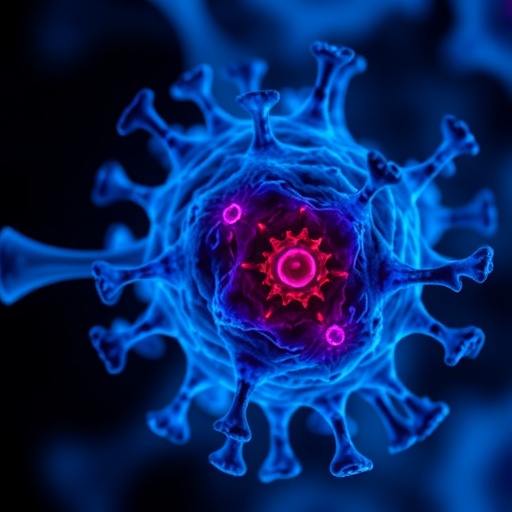Cancer metastasis remains one of the most formidable challenges in oncology, responsible for the vast majority of cancer-related fatalities worldwide. While solid tumours form the initial mass of many cancers, it is the migration and invasion of cancer cells into distant organs—a process known as metastasis—that often dictates prognosis and survival. Intriguingly, recent research from UNSW Sydney has highlighted a previously underappreciated mechanical aspect contributing to metastatic potential: the deformation and “squeezing” of cancer cells as they navigate the body’s narrowest blood vessels.
Scientists have long speculated that the physical microenvironment encountered by cancer cells in circulation plays a crucial role in their ability to colonize new tissues. This new study elucidates how the extreme mechanical stresses imposed by the confines of tiny capillaries can induce profound changes in cancer cell behavior. Specifically, researchers recreated the restrictive forces cancer cells endure during circulation using an innovative microfluidic device designed to mimic the human microvascular network. This allowed precise observation of how human melanoma cells react to being forced through channels narrower than 10 micrometres—roughly one-fifth the diameter of a human hair.
Through this bioengineered platform, constructed from biocompatible PDMS (polydimethylsiloxane), cancer cells were subjected to deformation comparable to physiological capillary constrictions. The exposure to these mechanical constraints triggered cancer cells to adopt stem cell-like phenotypes, a state believed to be more tumorigenic and highly capable of survival under hostile conditions. Proteomic analysis revealed upregulation of proteins associated with metastasis and cellular plasticity, demonstrating that mechanical forces alone can prime cancer cells for enhanced malignancy.
The significance of this transformation was underscored through in vivo experiments. When these mechanically “squeezed” melanoma cells were injected into immunodeficient mice, the animals developed significantly more secondary tumours in critical organs such as the lungs, bones, and brain, compared to mice injected with unsqueezed cells. These findings imply that physical deformation encountered during vascular transit acts as a key driver in metastasis progression, essentially reprogramming cancer cells into a more aggressive phenotype capable of colonizing distant tissues.
This discovery challenges the traditional view that metastasis is solely dependent on rare populations of pre-existing cancer stem cells. Instead, it suggests that the biomechanical landscape—specifically the constrictive forces within capillaries—can dynamically induce tumorigenic capabilities in otherwise less aggressive circulating tumour cells. This could revolutionize our understanding of cancer dissemination, shifting some focus from purely genetic and biochemical factors to include physical influences in the metastatic cascade.
The microfluidic model developed by Dr. Giulia Silvani and her team allowed for the real-time simulation of blood plasma flow at physiological rates through channels whose widths progressively narrowed from 30 micrometres down to just 5 micrometres. This high-resolution platform provided a rare window into the mechanical stress responses of cancer cells during their circulation journey. Given the difficulty in tracking these cells in vivo, this approach represents a significant technological advance in metastasis research.
Through detailed cellular and molecular analyses, the researchers uncovered a critical role for mechanosensitive ion channels such as PIEZO1 in mediating this phenotypic shift. PIEZO1 acts as a cellular sensor, translating mechanical forces into biochemical signals that activate cancer cell reprogramming. Targeting such mechanotransduction pathways could open new therapeutic avenues to prevent or diminish metastatic outgrowth by disrupting the mechanical cues essential for cancer cell transformation.
Importantly, melanoma was chosen as a model due to its well-known aggressive metastatic behavior and high mortality rates once it disseminates beyond the skin. However, the team is optimistic that similar squeezing-induced plasticity will be observed in other cancers, such as breast cancer, which may similarly exploit capillary constriction to enhance metastatic potential. This broad applicability could herald a paradigm shift in how cancer metastasis mechanisms are studied and targeted.
The implications for clinical practice and diagnosis are compelling. Researchers envisage a future where patient blood samples are analyzed not just for circulating tumor cell counts, but for cellular susceptibility to mechanical transformation. This might provide a personalized metastasis risk assessment. Additionally, imaging techniques like MRI could identify microvascular “hotspots” where constrictions favor cell squeezing, allowing targeted prevention strategies.
This research underscores the vital intersection of engineering, biology, and medicine. By integrating microfabrication technology with cellular biology, scientists have illuminated a mechanical trigger previously obscured in cancer metastasis. This multi-disciplinary approach promises to refine therapeutic strategies, combining traditional molecular targeting with mechanical interventions that impede cancer cell priming.
As the fight against metastasis continues, unraveling the mechanical microenvironments and their influence on cancer progression emerges as a promising frontier. The UNSW Sydney team’s findings advance this field, providing not only a mechanistic explanation for increased tumorigenicity but also a roadmap for novel diagnostic and therapeutic innovations aimed at preventing the deadly spread of cancer.
—
Subject of Research: Cells
Article Title: Capillary constrictions prime cancer cell tumorigenicity through PIEZO1
News Publication Date: 1-Sep-2025
Web References:
https://www.nature.com/articles/s41467-025-63374-6
References:
DOI: 10.1038/s41467-025-63374-6
Keywords: Metastasis, Cancer, Skin cancer, Blood vessels, Microfluidics




